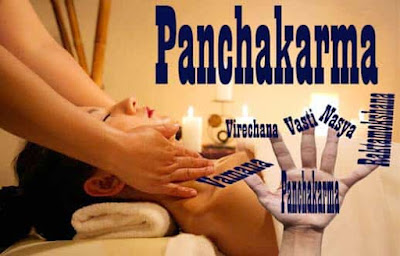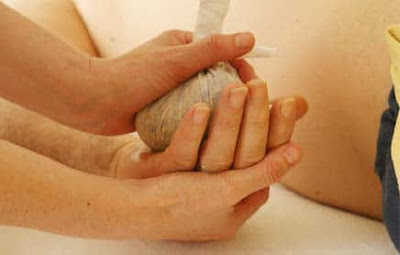Exactly what does
Panchakarma mean?
Panchakarma - The
Ultimate Five Healing Solutions for achieving balance in
body, mind, & soul - As the name suggests, five types of activities or
treatments including Vamana, Virechan,
Vasti, Nasya, and Raktamokshana are followed in this
therapy.
Actually, it is just a purification and rejuvenation procedures targeted at the cleansing of your
body. Ayurveda says that purification of the body is necessary before taking
almost any treatment.
There is absolutely no solution designed for cleansing
the body and/or mind in any other medical system throughout the world and this
is only one reason that Ayurveda experts believe that Panchakarma treatment is
a strong pillar of Ayurvedic system of medicine. This process is an integral
combination of Ayurveda and Yoga. By using these five methods, blood toxins are
taken out your body's closest orifices.
If you talk about the
basic aspects of Panchkarma therapy then it is important to talk about two
types of process. The foremost is Palliation therapy. The primary goal of palliative
treatment is to burn off or melt away the toxic substances (Ama) after
stimulating the digestive fire known as Agni in Ayurvedic set up of treatment.
Along with other is
known as Purification therapy which is employed to eliminate vitiated humour.
In Ayurveda, it is regarded as Shodhana therapy. It is a sophisticated
purification methodology of the body to take care of different kind of diseases
and increase longevity.
Therefore, without
doubt, we may contemplate it a gift or a boon of Ayurveda which was developed thousands of years back
and now its refined form is used.
Panchakarma therapy
always should be taken under the guidance of the Ayurveda and Panchkarma
expert. If it is attempted in an incorrect way, some serious side effects can
happen. As a precaution, Panchakarma therapies should not be taken during
pregnancy period, fever, and after injuries. Always make an appointment with
Panchakarma specialist before implementing these procedures so that he can make a decision according to your health states.
Five procedures
are being used in Panchakarma therapy which is divided
into these steps
Vamana -
It is
recognized as medicine induced emesis which is the first step of Panchakarma therapy. In this
particular form of therapy, an internal and external oleation and fomentation
are required for a couple of days to bringing in liquid form of the toxins and gathering in upper
cavities of the body. After that, the patient is given emetic medicine to
induce vomiting. For this function,
Madanaphala (Randia dumetorum) is used in this therapy. It
helps to eliminate systemic
toxins. It is especially recommended for kapha-dominated disorders like weight
problem, asthma, bronchitis, COPD, acidity, epilepsy, hypersomnia, goitre etc.
Virechana -
Additionally, it is called medicine induced purgation. In such a form of the method, intestines are cleansed by giving herbal laxative or
purgative to the patient.
This process is adopted
for putting off systemic toxins after giving internal and external oleation and fomentation therapies
to the patient. Nisoth (Operculina turpethum) is given as a laxative medicine
for this function.
Virechana is used to
dispel pitta-dominated conditions like jaundice,
constipation, colitis, dyspepsia, gastritis, dysphagia, gastric ulcer, piles,
splenomegaly, anal fistula, celiac disease, polydipsia, herpes zoster, eczema,
dermatitis, pimples, burning sensation, urticaria, pemphigus, liver
enlargement, vitiligo, psoriasis, helminthic disease, etc.
Vasti (Medicated enema) -
It is a form of medicated enema in
which herbal oil, decoction, ghee, or milk are used through the rectum. It is
used mainly for vata-dominated chronic diseases like constipation, hemorrhoids,
joint pain, gout, and sciatica. Apart from this, it is administered for other
various health issues like cervical-spondylosis, anuria, arthritis, calf
spasms, abdominal distension, blurred
vision, ataxia, prolapsed anus, aphasia, atrophy of the arm, loose motion,
flatulence, diaphragmatic spasm, convulsion, depression, headache, giddiness,
otalgia,tinnitus, emaciation, spleen enlargement, facial paralysis/ hemiplegia,
low back pain, neurasthenia, numbness of the feet, urinary retention, and so
on.
Nasya (Administration
of medicine through the nose) -
In this kind of
treatment, a nasal drop is administered to cleansing the head region. Before
starting the treatment, a therapeutic massage and fomentation of the head and shoulder regions
are necessary.
It is a very effective
treatment for a headache, migraine, sinusitis, sleep disorders, rhinitis, neurological problems, upper
respiratory catarrh, epilepsy etc.
Ayurveda suggests Anu
Taila and Shada bindu oil as a nasal drop in executing this therapy.
Raktamokshana (Blood purification therapy) -
It really is a blood-letting (a therapeutic withdrawal
of blood from the body for blood cleansing and purification purpose) procedure
which gives effective results in the vitiation of blood. Although this method
is practiced less nowadays because leech is used in it. Some people are afraid so much of leech and try to escape from this technique. This therapy is
well known for the treatment of psoriasis, eczema, allergic dermatitis,
abscesses, depigmentation, migraine attack, sciatic pain etc.
Apart from these, there
are some other
methods which are adopted in Panchakarma therapy and all the therapies are
equally important to undergo both as curative and preventive achievement and
that is next -
Abhyanga (Oil Massage) -
It's also a procedure of Panchakarma routines. It is performed in the
first stage called Purva Karma (pre-treatment) that generally accompanied by
svedana method. It is a kind of ayurvedic oil massage, in which a large amount
of warm oil is used to take care for the diseases including nerves
pain, joint pain, blood impurities, sleep disorders, anxiety, mental tension
and so on.
Based on the patient's condition, it is used to massage
whole body or specific parts may be involved like head, joints, upper and lower
extremities. Its use is beneficial to
make body parts lubricated and to calm the vata defects.
Vaspa Svedana (Steam
Bath) -
In this method, the
whole body is kept in a steam chamber except the head and
some essential herbs are put together in
the water of steam chamber to get rid of some health conditions. This method
helps in increasing blood circulation and putting off surplus
water from the body. It is well indicated in the conditions of joint pain,
obesity, general weakness etc.
Shirodhara -
It is a specific and traditional therapy in which a stream
of warm medicated oil is poured on the center of the forehead constantly. It is
adapted for the treatment of head-related disorders. It is a useful procedure
to promote sound sleep, reduce mental stress, relax the mind, improves
concentration, nourishes hair and scalp, and so forth.
Potli Massage -
Potli massage is performed with heated special
bags/pouches stuffed with fresh and dried out herbs. It is of two types - Wet
(Snigdha) and Dry (Shushka) Potli massage and selection of herbs or other items
are done in accordance with the type of disease and physical condition of the
patient.
In wet Potli massage,
herbal oil is utilized to manage Vata associated conditions like paralysis,
osteoarthritis, spondylosis, frozen shoulder, rheumatoid arthritis etc. while
dry Potli massage is done with a pouch of the sand or dry herbs powder. Dry
Potli massage is required in the cases of joint inflammation, muscular pain
etc.
Pizhichil -
Relating to Ayurveda, Pizhichil interprets squeezing
which is a balanced combination of oil massage and heat treatment. In this kind
of treatment, two therapist works mutually and pour continuous streams of
lukewarm herbal oil on the whole body and after that, a soft digital massage
with rhythmic pressure is performed. Pizhichil is called Sarvanghdhara (
Sarvangh = entire body & dhara = stream) in Sanskrit term and indicated in
stress, arthritis, muscular pain, nerves pain, paralysis, sexual weakness etc.
and apart from this, it retains skin young, improves immunity level, and
prevent aging.
Parts/Elements of Panchakarma
Mainly Panchakarma
therapy is conducted into 3 phases named as Purva karma (Initial treatment),
Pradhana Karma (Essential treatment), and Paschat karma (After practices)
In Purva karma (Preliminary practices), whose goal is primarily detoxification of the body. Purva
karma is followed before Panchakarma procedure. Udvartanam, Kati Vasthi,
UroVasthi, Shirodhara, Snehana, Svedana, and Pizhichil are believed to be an
important part of the preliminary practice.
The second phase is
called Pradhana Karma (Vital practices) wherein Vamana
(Emesis), Virechana (Purgation), Vasti (Medicated Enema), Nasya (Nasal
Medication), and Raktamokshana (Blood purification) are done to putting off
blood impurities.
In the third phase, a
successful attempt is made to bring the body into a normal and standard
condition while rejuvenation can be started out with proper and healthy diet
regiment, lifestyle modification, and herbs administration.
Health Benefits of
Panchakarma Treatment
Panchakarma is some sort
of natural gift that can bring up unlimited health benefits to
help people in different ways. It may help in -
Eliminates blood
impurities and toxins.
Reduces body weight.
Improves digestive fires
and accelerating the metabolism.
Rejuvenates affected
tissues.
Enhances immunity
system.
Relieves stress and
relaxes the body and mind.
Balances vitality
including Vata, Pitta, and Kapha.
Improves skin tone,
appearance, and the overall flexibility of joints.
Apart from these,
Panchakarma therapy is also helpful in the cases of diabetes, digestive
disorders (irritable bowel syndrome,constipation,indigestion, hyperacidity,
colitis,), asthma, sciatic pain, weight problem, cervical spondylosis,
paraplegia, headaches, hemorrhoids, sexual weakness, migraine, sinusitis,
vitiligo, psoriasis, edema, and many others.
----------------------------------------
WRITTEN BY RAJESH KUMAR














No comments:
Post a Comment